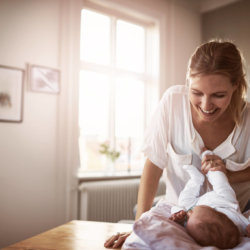
You don’t have to be a detective to spot harmful ingredients in cleaning products that will endanger your loved ones. For starters, never assume that because a cleaning product has a label that reads “organic” or “all-natural,” it actually is.
Start reading your cleaning products’ labels like you would the nutrition facts on your groceries. It’s the first step to adopting a “green cleaning” mindset. One of the most obvious signs to be leery of are the words on the product itself. Dangerous cleaning products usually have one or more of these words printed on their packaging:
– Wash hands thoroughly after use
– Keep away from the eyes
– Keep out of reach of children
– Toxic
– Caution
– Warning
– Danger
While you’re at it, bookmark EWG’s guide to decoding ingredients on labels. That way, you’ll always be ready to make the best decision on cleaning products for your household. For a quick and easy way to determine if the chemicals in your cleaning products are toxic, look for the “trio of toxicity,” a set of ingredients that can make your cleaning less soothing and more scary. Here’s an overview courtesy of EthicalConsumer.org:
Parabens
Parabens are a group of compounds widely used as an antifungal agent, preservative and antimicrobial. According to breast cancer charities, they are absorbed through the skin and have been identified in biopsy samples from breast tumours. Parabens are also linked to hormone disruption, reproductive toxicity, immunotoxicity, neurotoxicity and skin irritation. The EU has banned five parabens from cosmetics but not the most common ones used in products – methylparaben, propylparaben, and butylparaben. However, it has restricted the amounts of these that can be used in products.
Triclosan
Triclosan and triclocarban can be used as an antimicrobial in cleaning products. Its use in toothpaste, mouthwash, deodorants, cosmetics and hand soaps is restricted by the EU whilst, last year, the US banned its use in liquid soaps and bars of soap. Triclosan, which is classified as a pesticide, can affect the body’s hormone systems – especially thyroid hormones, which regulate metabolism – and may disrupt normal breast development. The EU classifies triclosan as irritating to the skin and eyes, and as very toxic to aquatic organisms, noting that it may cause long-term adverse effects in the aquatic environment. Widespread use of triclosan may also contribute to bacterial resistance to antimicrobial agents.
Phthalates
Phthalates are a group of hormone-disrupting chemicals that are most commonly used to make PVC soft and flexible but are also in synthetic fragrances. Fragrances are in everything from shampoo to deodorant and laundry detergent. Phthalate exposure has been linked to early puberty in girls, a risk factor for later-life breast cancer. Several phthalates have been banned in the EU but not all, including diethyl phthalate (DEP). Because the chemical constituents of ‘fragrance’ or ‘parfum’ do not have to be listed on labels, one way to avoid phthalates altogether is to go for fragrance-free products or those free of synthetic fragrances
Looking for more tips? Continue reading our blog or learn more about our services! Have any questions? Leave a comment below.



